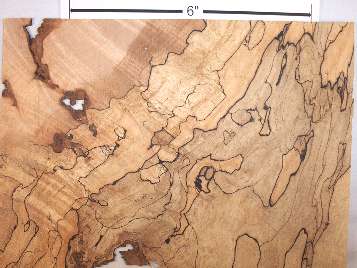

Walnut and Black Cherry for example basically do not spalt, other than the sapwood. Spalted Persimmon with Insect Galleries Some species of tree just rot more quickly than others. Oaks are a good example here, as the sapwood will spalt in a few months and the heartwood is basically untouched. Older trees tend to have less sapwood than younger ones and generally decay less quickly.

Sapwood spalts much more quickly than heartwood, the fungi feed more rapidly on the sugars in the sapwood. Other factors that influence spalting rates are the age of the tree and the species of the tree. He says it helps bring out the color in the burl, though I wonder if fungi might have something to do with it. Mike Jackofsky I recall sprays his burls that he purchases with a hose and covers them up (He is in the San Diego area). Conversely, if trying to promote spalting in arid climates then keep the wood covered and wet. Fungi require moisture so cover up the wood and let it dry out to stop the wood from spalting. There is a bit of an art in knowing when to stop letting the wood spalt before it is no longer usable. Wood is referred as being “punky” when it reaches this condition. The longer the wood is left to spalt the greater the risk that the wood is no longer usable as it breaks apart too easily. Fungal activity creates attractive patterns though it comes at the cost of the wood’s structural integrity.

Spalting in wood is a double-edged sword for the woodworker. Where I live everything spalts if left outside. Moisture is critical for the decay process so arid climates are naturally going to have limited to no spalting. Spalting is a by-product of the decay process in trees, so the wetter the climate the greater the degree of spalting.
#SPALTED AMBROSIA MAPLE HOW TO#
…how to find spalted wood… Perhaps you are wondering how to find spalted wood? The easiest way is to look for flushes of mushrooms on the wood surface. For me its rare as I have only ever found it in this particular Dogwood tree and one other spalted maple burl that I have found. I refer to this as “ fine line spalting” (my term) and I find it absolutely incredible. Looking at the spalted Dogwood shown here, the precision or line weight of the zone lines is so fine. Horsehair pottery creates an effect that is similar to zone line patterning. With zone lines, no two pieces of wood are identical.

Zones lines are extremely diverse in their thickness and arrangement. They are the visual representation of the interface boundary created when two opposing fungi grow and come in contact with one another. patterns of random lines created in the wood. Ultra Gloss Fine Line Spalted Dogwood Zone lines are the black (most common), gray, brown, etc. People have been using spalted wood in woodwork, art, and sculpture for hundreds of years. Likewise, I usually only find red stain in magnolia, sweet gum, tulip poplar, and spalted pecan. bluegreen stain in holly, blue stain in maple, brown rot in oak, etc. Thus, some colors are more common in cooresponding species, i.e. The species of tree also plays a role as some types of fungus prefer certain species of tree. These stains are a lot more UV resistant than commercially developed colorants today. In actuality the whole spectrum of colors is possible, these are just the most prevalent in my climate. However, yellows, oranges, reds, purples, whites, and greens are also possible. Most commonly (in my area) blues, grays, browns, and blacks are found primarily in spalted maple. Generally, spalting results in the creation of zone lines and staining, the color of which will be influence by the type of fungus present. By the way, “Spalted Wood” is an excellent book and goes a lot more in depth than this post will. From “Spalted Wood” (Sara Robinson) “spalting is a process that occurs on wood when fungi colonize the substrate and extract various nutrients”. If you have seen it its probably been some spalted maple. Spalting is a common woodworking term used to describe the colorations and patterning created by the growth of fungus in wood. Now for some Spalted Wood Background… So what is spalted wood or what does spalted mean? Not surprisingly most people (outside of woodworkers) have no idea what spalting is, even autocorrect doesn’t have a clue. Jump to the list of materials at the end of the article. This article covers information on what spalting is and how it can be used in woodwork, specifically wood turning. That being said I spalt just about every species that I get a hold of. In my area spalted maple is most common and the most diverse spalting species. I primarily turn sculptural vessels and cremation urns and proactively take steps to spalt a lot of the wood that I gather. Ben Owen Spalted Pecan Spalted wood is one of my main turning materials, when considering wood with some figure.


 0 kommentar(er)
0 kommentar(er)
